If the Art History thing doesn't work out and I never follow through with the Astronomy thing (which I probably wouldn't) and I decide that I DON'T actually want to end up as a high school English teacher, I think I would like to open a restaurant. Nothing fancy, just a little place where I can offer to people like me the things that I can not find in a restaurant.
Karlen: Where would you like to eat tonight?
Kyle: I don't know. Somewhere with vegetarian options and drink specials.
Karlen: Um, TFB, bro.
Kyle: Yeah, I just severely limited our options down to none.
Wednesday, May 20, 2009
Monday, May 18, 2009
Zombie Apocalypse
Five items I would want to have if I survived the Zombie Apocalypse:
1) A ball-peen hammer. Hammers are great close-range weapons. During a zombie attack, you don't want to only have a gun because it makes too much noise and would only serve to attract more zombies. Also, if I was being attacked by zombies I would not trust myself with a firearm, so I'll leave that to others with more gun experience. Claw hammers may get stuck in necrotic flesh, so the ball-peen is really the way to go. Kyle will have his rifle for emergency situations and a FUBAR (no, that's really what it's called) so I think between the two of us, we'll be able to handle at least a few of the undead horde.
2) My Doc Marten steel-toed boots. I actually decided I wanted a pair of these not long after I read The Zombie Survival Guide and received a pair from my Aunt Anne for Christmas of 2007. Not only are they awesome and stylish, they're also good for running from flesh-eaters, water resistant, and the steel-toes make them durable and protective. Your feet will be very important after the zombie apocalypse. Invest in excellent shoes. Note: I feel that everyone, especially my mother, should adopt this as a life motto and then apply it every time a fantastic pair of Skechers or Rocket Dogs pops out at her.
3) A size H crochet hook. This probably needs some explanation. While trying to come up with my personal five items, I tried to think of items I could use to really contribute to life after civilization. With a crochet hook, I can recycle pretty much any textile into clothes, blankets, socks, passable ropes, etc. A size H hook is a great all-purpose hook and my personal size H is the only hook I have that has a squishy thumb rest addition so I can use it for much longer periods of time because it's so comfy!
4) Duct tape. I hear it's very useful. I have a roll that I bought when my glove compartment fell off and I tried to duct tape it back on (which didn't actually work - way to not live up to it, duct tape) but I HEAR it's very useful so I would bring that roll.
5) My emergency backpack. I don't know if this is cheating since it contains WAY more than 5 items but it is something I keep available at all times so I'm going to count it because, um, what's a bigger emergency than the dead rising to destroy us all? I have an old backpack that contains items such as:
-adhesive bandages and Neosporin
-vitamins, antacids, Dramamine, ibuprofen, Imodium, No-Doze, and breath mints (they were just there)
-tampons
-tissues
-travel toothbrush and toothpaste
-a few bars of hotel soap
...and that's just the things I can recall at the moment. Obviously, a backpack would also be good for carrying other things but doesn't that sound like a pretty good kit? Also, this is basically a list of things I carried in my purse in high school because I've been becoming my mother since I hit puberty. Preparedness!
And that's my list. I'm assuming there will be lots of other survivors whose lists include USEFUL things like canned foods or water (or those water cleaning tablets) or matches, lighters, sticks and flint rocks, fire blankets and tarps, containers of gasoline, pocket knives, toilet paper, etc. Maybe I can barter with my lovely crocheted socks and my antacids. We'll make it, guys.
1) A ball-peen hammer. Hammers are great close-range weapons. During a zombie attack, you don't want to only have a gun because it makes too much noise and would only serve to attract more zombies. Also, if I was being attacked by zombies I would not trust myself with a firearm, so I'll leave that to others with more gun experience. Claw hammers may get stuck in necrotic flesh, so the ball-peen is really the way to go. Kyle will have his rifle for emergency situations and a FUBAR (no, that's really what it's called) so I think between the two of us, we'll be able to handle at least a few of the undead horde.
2) My Doc Marten steel-toed boots. I actually decided I wanted a pair of these not long after I read The Zombie Survival Guide and received a pair from my Aunt Anne for Christmas of 2007. Not only are they awesome and stylish, they're also good for running from flesh-eaters, water resistant, and the steel-toes make them durable and protective. Your feet will be very important after the zombie apocalypse. Invest in excellent shoes. Note: I feel that everyone, especially my mother, should adopt this as a life motto and then apply it every time a fantastic pair of Skechers or Rocket Dogs pops out at her.
3) A size H crochet hook. This probably needs some explanation. While trying to come up with my personal five items, I tried to think of items I could use to really contribute to life after civilization. With a crochet hook, I can recycle pretty much any textile into clothes, blankets, socks, passable ropes, etc. A size H hook is a great all-purpose hook and my personal size H is the only hook I have that has a squishy thumb rest addition so I can use it for much longer periods of time because it's so comfy!
4) Duct tape. I hear it's very useful. I have a roll that I bought when my glove compartment fell off and I tried to duct tape it back on (which didn't actually work - way to not live up to it, duct tape) but I HEAR it's very useful so I would bring that roll.
5) My emergency backpack. I don't know if this is cheating since it contains WAY more than 5 items but it is something I keep available at all times so I'm going to count it because, um, what's a bigger emergency than the dead rising to destroy us all? I have an old backpack that contains items such as:
-adhesive bandages and Neosporin
-vitamins, antacids, Dramamine, ibuprofen, Imodium, No-Doze, and breath mints (they were just there)
-tampons
-tissues
-travel toothbrush and toothpaste
-a few bars of hotel soap
...and that's just the things I can recall at the moment. Obviously, a backpack would also be good for carrying other things but doesn't that sound like a pretty good kit? Also, this is basically a list of things I carried in my purse in high school because I've been becoming my mother since I hit puberty. Preparedness!
And that's my list. I'm assuming there will be lots of other survivors whose lists include USEFUL things like canned foods or water (or those water cleaning tablets) or matches, lighters, sticks and flint rocks, fire blankets and tarps, containers of gasoline, pocket knives, toilet paper, etc. Maybe I can barter with my lovely crocheted socks and my antacids. We'll make it, guys.
Thursday, May 7, 2009
"She's a Rascal I Wouldn't Trust an Inch"
I read a blog called Alberti's Window and today there was a post on images of washer women. There's an amusing story about how the author came up with the idea for a post on such an unusual topic but even better is the art itself. I particularly like this one:
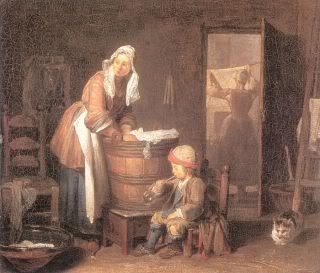
Go on over and check out the rest of the post!

Go on over and check out the rest of the post!
Wednesday, May 6, 2009
Welcome to the Club. We Have Jackets.
Kyle: While I was out running this nasty old woman comes staggering towards me, hocks this huge loogie, and then yells "Hey, baby, you want a little of this?"
Karlen: Wow, that's pretty much what women put up with regularly!
Kyle: ...I have to take a shower.
Karlen: Wow, that's pretty much what women put up with regularly!
Kyle: ...I have to take a shower.
Tuesday, May 5, 2009
Guernica by Picasso
Name: Guernica
Artist's Name: Pablo Picasso
Date: 1937
Period: Cubist
Material: Oil on canvas
Compelled by the worldwide outcry after the bombing of the town of Guernica, Spain, by Nazi planes acting on behalf of rebel general Francisco Franco, Picasso completed the huge 11 1/2' X 25 1/2' Guernica in less than two months. This monumental painting condemns the senseless bombing without specific reference to the event - depicting no bombs or German planes. The collection of figures creates a visceral feeling of grief and terror. In the center, along the lower edge, a figure lies slain and holding a broken sword. A wounded horse tramples the fiure and rears back in fright as it dies. On the left, a woman shrieks in anguish as she cradles the body of her dead child. Women flee from burning buildings. One holds a light to survey the damage. The head of a bull overlooks the death and destruction. According to the artist, the bull represents "brutality and darkness". The use of only black, white & gray gives the painting the feeling of a newspaper article.

Artist's Name: Pablo Picasso
Date: 1937
Period: Cubist
Material: Oil on canvas
Compelled by the worldwide outcry after the bombing of the town of Guernica, Spain, by Nazi planes acting on behalf of rebel general Francisco Franco, Picasso completed the huge 11 1/2' X 25 1/2' Guernica in less than two months. This monumental painting condemns the senseless bombing without specific reference to the event - depicting no bombs or German planes. The collection of figures creates a visceral feeling of grief and terror. In the center, along the lower edge, a figure lies slain and holding a broken sword. A wounded horse tramples the fiure and rears back in fright as it dies. On the left, a woman shrieks in anguish as she cradles the body of her dead child. Women flee from burning buildings. One holds a light to survey the damage. The head of a bull overlooks the death and destruction. According to the artist, the bull represents "brutality and darkness". The use of only black, white & gray gives the painting the feeling of a newspaper article.

The Red Room by Matisse
Name: The Red Room (Harmony in Red)
Artist's Name: Henri Matisse
Date: 1908-1909
Period: Fauvism
Material: Oil on canvas
For Matisse and the Fauves color was the formal element most responsible for pictorial coherence and the primary conveyor of meaning. The theory behind these color discoveries can be found in Red Room. The scene is the interior of a comfortable, prosperous household with a maid setting a table with wine and fruit. The color selections generate a feeling of warmth and comfort, while contrasting richly and intensely. This painting was originally done in green and then blue before being covered with the red that fit Matisse's intention of provoking an emotional resonance in the viewer.
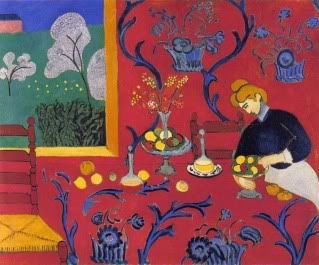
Artist's Name: Henri Matisse
Date: 1908-1909
Period: Fauvism
Material: Oil on canvas
For Matisse and the Fauves color was the formal element most responsible for pictorial coherence and the primary conveyor of meaning. The theory behind these color discoveries can be found in Red Room. The scene is the interior of a comfortable, prosperous household with a maid setting a table with wine and fruit. The color selections generate a feeling of warmth and comfort, while contrasting richly and intensely. This painting was originally done in green and then blue before being covered with the red that fit Matisse's intention of provoking an emotional resonance in the viewer.

Akua'ba by Bonsu
Name: Akua'ba
Artist's Name: Osei Bonsu
Date: ca. 1935
Period: 20th century African
Material: Wood, beads, and pigment
These small dolls acted as fertility tokens for Akan women. The simplified wood sculptures were consecrated at a shrine, then carried by a woman hoping to conceive. Once pregnant, the woman continued to carry the figure to ensure the safe delivery of a healthy and handsome child, preferably a girl. Each akua'ba is different and this one reflects aspects of Bonsu's style: a more naturalistic rendering of the face and crosshatched eyebrows.
Note: I couldn't find a picture on the internet of the specific akua'ba in my book. This one is similar in shape and general idea but the one in my book is much cooler.

Artist's Name: Osei Bonsu
Date: ca. 1935
Period: 20th century African
Material: Wood, beads, and pigment
These small dolls acted as fertility tokens for Akan women. The simplified wood sculptures were consecrated at a shrine, then carried by a woman hoping to conceive. Once pregnant, the woman continued to carry the figure to ensure the safe delivery of a healthy and handsome child, preferably a girl. Each akua'ba is different and this one reflects aspects of Bonsu's style: a more naturalistic rendering of the face and crosshatched eyebrows.
Note: I couldn't find a picture on the internet of the specific akua'ba in my book. This one is similar in shape and general idea but the one in my book is much cooler.

Burghers of Calais by Rodin
Name: Burghers of Calais
Artist's Name: Auguste Rodin
Date: 1884-1889
Period: Realist
Material: Bronze
Purpose: Commission for public monument, Calais, France
During the English siege of Calais in 1347, six of the city's leading citizens offered their lives to lift the siege and spare the rest of the populace. Rodin shows these six figures in a convincing study of despair, resignation, or quiet defiance. The burghers seem to wander aimlessly and the roughly textured surfaces make them look bedraggled and compel the viewer. Rodin designed the monument without the traditional high base so that the citizens of Calais could be eye-level with their ancestors as they prepare eternally to set off on their sacrificial journey.

Artist's Name: Auguste Rodin
Date: 1884-1889
Period: Realist
Material: Bronze
Purpose: Commission for public monument, Calais, France
During the English siege of Calais in 1347, six of the city's leading citizens offered their lives to lift the siege and spare the rest of the populace. Rodin shows these six figures in a convincing study of despair, resignation, or quiet defiance. The burghers seem to wander aimlessly and the roughly textured surfaces make them look bedraggled and compel the viewer. Rodin designed the monument without the traditional high base so that the citizens of Calais could be eye-level with their ancestors as they prepare eternally to set off on their sacrificial journey.

The Bath by Cassatt
Name: The Bath
Artist's Name: Mary Cassatt
Date: ca. 1892
Period: Post-Impressionism
Material: Oil on canvas
Although Cassatt was a close friend to Degas and frequently exhibited with the Impressionists, because she was a woman her choice of subject matter was quite limited. Her subjects were typically women and children, whom she presented with a combination of objectivity and genuine sentiment. Her work, The Bath owes much to the compositional devices of Degas and of Japanese prints. The visual solidity of the mother and child contrasts with the flattened patterning of the wallpaper and rug.
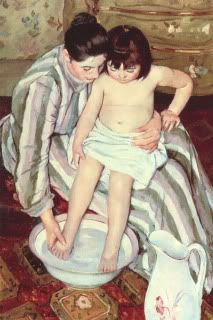
Artist's Name: Mary Cassatt
Date: ca. 1892
Period: Post-Impressionism
Material: Oil on canvas
Although Cassatt was a close friend to Degas and frequently exhibited with the Impressionists, because she was a woman her choice of subject matter was quite limited. Her subjects were typically women and children, whom she presented with a combination of objectivity and genuine sentiment. Her work, The Bath owes much to the compositional devices of Degas and of Japanese prints. The visual solidity of the mother and child contrasts with the flattened patterning of the wallpaper and rug.

The Third-Class Carriage by Daumier
Name: The Third-Class Carriage
Artist's Name: Honore Daumier
Date: ca. 1862
Period: Modernism
Material: Oil on canvas
Daumier was known as a champion of the urban working class, the disinherited masses of 19th-century industrialism. Third-Class Carriage shows the viewer into the cramped and grimy railway carriage of the 1860's. The scene is painted candidly, the faces of his figures blank and dumbly patient. The painting is sketchy and incomplete, which lends well to the vague and impersonal subject matter.
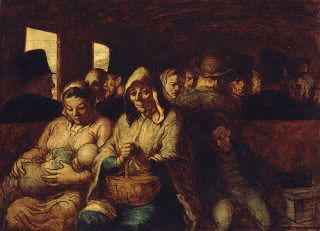
Artist's Name: Honore Daumier
Date: ca. 1862
Period: Modernism
Material: Oil on canvas
Daumier was known as a champion of the urban working class, the disinherited masses of 19th-century industrialism. Third-Class Carriage shows the viewer into the cramped and grimy railway carriage of the 1860's. The scene is painted candidly, the faces of his figures blank and dumbly patient. The painting is sketchy and incomplete, which lends well to the vague and impersonal subject matter.

Third of May, 1808 by Goya
Name: The Third of May, 1808
Artist's Name: Francisco Goya
Date: 1814
Period: Spanish Romanticism
Material: Oil on canvas
The tragic events of May 3rd, 1808, became the subject of one of Goya's most famous paintings. On May 2nd, Spanish soldiers attacked the invading Napoleonic troops in a chaotic and violent clash. The next day, French soldiers responded by executing numerous Spanish citizens. Goya's painting depicts the faceless French soldiers murdering terrified and unarmed Spanish peasants. Their expressions are horrified and anguished and one peasant about to be shot throws his arms out in a gesture referring to Christ's position on the cross. Goya's use of high contrast darks and lights add drama to this piece. Other peasants, their blood staining the soil, lay dead at the man's feet on one side and more waiting execution are at his other side.
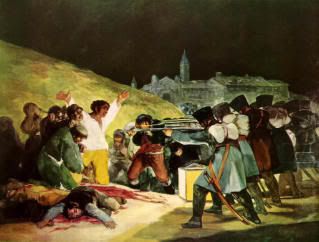
Artist's Name: Francisco Goya
Date: 1814
Period: Spanish Romanticism
Material: Oil on canvas
The tragic events of May 3rd, 1808, became the subject of one of Goya's most famous paintings. On May 2nd, Spanish soldiers attacked the invading Napoleonic troops in a chaotic and violent clash. The next day, French soldiers responded by executing numerous Spanish citizens. Goya's painting depicts the faceless French soldiers murdering terrified and unarmed Spanish peasants. Their expressions are horrified and anguished and one peasant about to be shot throws his arms out in a gesture referring to Christ's position on the cross. Goya's use of high contrast darks and lights add drama to this piece. Other peasants, their blood staining the soil, lay dead at the man's feet on one side and more waiting execution are at his other side.

Grande Odalisque by Ingres
Name: Grande Odalisque
Artist's Name: Jean-Auguste-Dominique Ingres
Date: 1814
Period: Neoclassicism
Material: Oil on canvas
Although Ingres was firmly planted in the Neoclassical style, some of his works made strong concessions to the influence of movements past and contemporary. Ingres' Grande Odalisque was homage to the reclining nudes of Titian and Giorgione and the woman's head and face borrow heavily from the women of Raphael's work. Her small head and elongated limbs, her languid pose and the subtle, cool color scheme hearken to the Mannerists, such as Parmigianino. By making the figure a Turkish odalisque, the artist gave a nod to the contemporary Romantic movement.
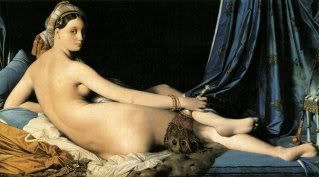
Artist's Name: Jean-Auguste-Dominique Ingres
Date: 1814
Period: Neoclassicism
Material: Oil on canvas
Although Ingres was firmly planted in the Neoclassical style, some of his works made strong concessions to the influence of movements past and contemporary. Ingres' Grande Odalisque was homage to the reclining nudes of Titian and Giorgione and the woman's head and face borrow heavily from the women of Raphael's work. Her small head and elongated limbs, her languid pose and the subtle, cool color scheme hearken to the Mannerists, such as Parmigianino. By making the figure a Turkish odalisque, the artist gave a nod to the contemporary Romantic movement.

Distractions
From Shakesville: "Fran & Marlo Cowan, who have been married for 62 years, play an impromptu recital together in the atrium of the Mayo Clinic, September 2008."
Sunday, May 3, 2009
Return of the Prodigal Son by Rembrandt
Name: The Return of the Prodigal Son
Artist's Name: Rembrandt
Date: ca. 1620
Period: Baroque
Material: Oil on canvas
Rembrandt depicted biblical scenes and religious works that were quiet and introspective, unlike most other religious painting of the time that intended to glorify the church with grandiose, highly decorated paintings. In Return of the Prodigal Son, the father embraces the son in forgiveness while the son kneels in contrition. They are placed forward in the frame and highlighted against a dark backdrop. The doubtful bystanders are veiled to varying degrees in shadow and set back from the major action of the scene.

Artist's Name: Rembrandt
Date: ca. 1620
Period: Baroque
Material: Oil on canvas
Rembrandt depicted biblical scenes and religious works that were quiet and introspective, unlike most other religious painting of the time that intended to glorify the church with grandiose, highly decorated paintings. In Return of the Prodigal Son, the father embraces the son in forgiveness while the son kneels in contrition. They are placed forward in the frame and highlighted against a dark backdrop. The doubtful bystanders are veiled to varying degrees in shadow and set back from the major action of the scene.

Judith Slaying Holofernes by Gentileschi
Name: Judith Slaying Holofernes
Artist's Name: Artemisia Gentileschi
Date: ca. 1614
Period: Baroque
Material: Oil on canvas
Gentileschi was greatly inspired by Caravaggio and this fact is obvious in Judith Slaying Holofernes. The highly theatrical lighting and placement of the figures close to the viewer against a darkened background, and the dark subject matter make this painting very much like a Caravaggio. There is a lot of drama and emotion in this piece: the fear and pain on Holofernes' face while he struggles to push the women off him, the determination in the faces of Judith and her maid as they hold the man down and remove his head, the blood spurting and staining the bedsheets. Gentileschi was also adept at the use of color. The red of Holofernes' blanket mirrors the spraying blood and the trim of Judith's dress.

Artist's Name: Artemisia Gentileschi
Date: ca. 1614
Period: Baroque
Material: Oil on canvas
Gentileschi was greatly inspired by Caravaggio and this fact is obvious in Judith Slaying Holofernes. The highly theatrical lighting and placement of the figures close to the viewer against a darkened background, and the dark subject matter make this painting very much like a Caravaggio. There is a lot of drama and emotion in this piece: the fear and pain on Holofernes' face while he struggles to push the women off him, the determination in the faces of Judith and her maid as they hold the man down and remove his head, the blood spurting and staining the bedsheets. Gentileschi was also adept at the use of color. The red of Holofernes' blanket mirrors the spraying blood and the trim of Judith's dress.

Death of Sardanapalus by Delacroix
Name: The Death of Sardanapalus
Artist's Name: Eugene Delocroix
Date: 1826
Period: Romantic
Material: Oil on canvas
This painting was inspired by the Lord Byron poem but the ending is shown quite differently. Sardanapalus hears that he is under siege and there is no hope for fighting back so he watches as everything he "loves" is destroyed before he burns to death on his funeral pyre. This isn't so much the death of Sardanapalus as it is the death of his servants, concubines and horse. For some reason, the authors of the book [Gardner's Art Through the Ages, 12th Ed. Vol. II] thought it necessary to emphasize how "sexy" this painting is, using words like "orgiastic" and "erotic". They don't say why they suppose that this is a "fantasy of the artist" but it really makes me question their interpretation rather than the artist's intention. The Romantic period focused on telling exotic stories to take the viewer away from their regular lives.

Artist's Name: Eugene Delocroix
Date: 1826
Period: Romantic
Material: Oil on canvas
This painting was inspired by the Lord Byron poem but the ending is shown quite differently. Sardanapalus hears that he is under siege and there is no hope for fighting back so he watches as everything he "loves" is destroyed before he burns to death on his funeral pyre. This isn't so much the death of Sardanapalus as it is the death of his servants, concubines and horse. For some reason, the authors of the book [Gardner's Art Through the Ages, 12th Ed. Vol. II] thought it necessary to emphasize how "sexy" this painting is, using words like "orgiastic" and "erotic". They don't say why they suppose that this is a "fantasy of the artist" but it really makes me question their interpretation rather than the artist's intention. The Romantic period focused on telling exotic stories to take the viewer away from their regular lives.

Saturday, May 2, 2009
David by Bernini
Name: David
Artist's Name: Bernini
Date: 1623
Period: Baroque
Material: Marble
Purpose: Commission for Cardinal Borghese
Unlike the Davids of the Renaissance, Bernini's David is shown in action, rather than in repose after action. His hips swivel and his shoulders turn in preparation to release the stone from his sling and take down Goliath. Also unlike Renaissance sculpture, Bernini's David is not "self-sufficient". He requires more physical space to move into and directs attention away from himself to the imagined approaching giant. His twisting body and the intense expression on his face add drama along with the theatrical billowing of his garment.
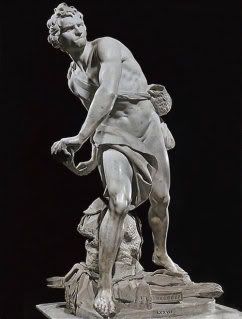
Artist's Name: Bernini
Date: 1623
Period: Baroque
Material: Marble
Purpose: Commission for Cardinal Borghese
Unlike the Davids of the Renaissance, Bernini's David is shown in action, rather than in repose after action. His hips swivel and his shoulders turn in preparation to release the stone from his sling and take down Goliath. Also unlike Renaissance sculpture, Bernini's David is not "self-sufficient". He requires more physical space to move into and directs attention away from himself to the imagined approaching giant. His twisting body and the intense expression on his face add drama along with the theatrical billowing of his garment.

The Swing by Fragonard
Name: The Swing
Artist's Name: Jean-Honore Fragonard
Date: 1766
Period: Rococo
Material: Oil on canvas
Purpose: Private "intrigue" picture
Rococo themes centered on love, pursued through erotic frivolity and playful intrigue. Artful fantasy paintings became ornamental reflections on the cherished pastimes or the wealthy French. Fragonard's The Swing is typical of this personal keepsake style. An unsuspecting old bishop pushes a pretty young woman on a swing. In front of her lies her lover, the work's patron, strategically positioned. As the swing reaches its full height, the woman kicks off her shoe at the statue of Cupid holding a finger to his lips, boldly and flirtatiously lifting her skirt in the process. The glowing pastel colors and soft light convey the theme's sensuality.
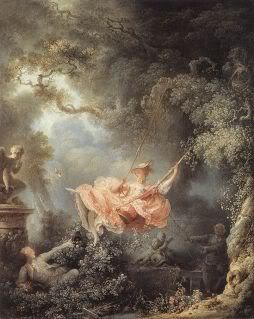
click for larger image
Artist's Name: Jean-Honore Fragonard
Date: 1766
Period: Rococo
Material: Oil on canvas
Purpose: Private "intrigue" picture
Rococo themes centered on love, pursued through erotic frivolity and playful intrigue. Artful fantasy paintings became ornamental reflections on the cherished pastimes or the wealthy French. Fragonard's The Swing is typical of this personal keepsake style. An unsuspecting old bishop pushes a pretty young woman on a swing. In front of her lies her lover, the work's patron, strategically positioned. As the swing reaches its full height, the woman kicks off her shoe at the statue of Cupid holding a finger to his lips, boldly and flirtatiously lifting her skirt in the process. The glowing pastel colors and soft light convey the theme's sensuality.

click for larger image
Galerie des Glaces at Versailles
Name: Galerie des Glaces (Hall of Mirrors) at Versailles
Artist's Name: designed by Jules Hardouin-Mansart and Charles Le Brun
Date: ca. 1680
Period: French Baroque
Purpose: Overlooks the park from the second floor and extends alomg most of the width of the central block.
When Louis XIV gathered together a veritable army of architects, decorators, sculptors, painters and landscape architects to convert a royal hunting lodge into a palace, it because the greatest architectural project of the age. The Galerie des Glaces is probably the most famous of the richly decorated rooms and halls at Versailes. Its original furniture, including gold and silver chairs and bejeweled trees, has been removed but the halls splendor is retained by the hundreds of mirrors set into the wall opposite the windows, which gives the room an expansive quality.
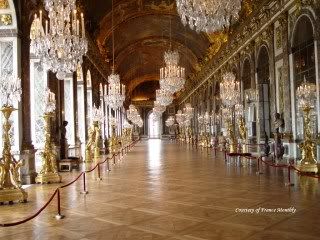
click for larger image
Artist's Name: designed by Jules Hardouin-Mansart and Charles Le Brun
Date: ca. 1680
Period: French Baroque
Purpose: Overlooks the park from the second floor and extends alomg most of the width of the central block.
When Louis XIV gathered together a veritable army of architects, decorators, sculptors, painters and landscape architects to convert a royal hunting lodge into a palace, it because the greatest architectural project of the age. The Galerie des Glaces is probably the most famous of the richly decorated rooms and halls at Versailes. Its original furniture, including gold and silver chairs and bejeweled trees, has been removed but the halls splendor is retained by the hundreds of mirrors set into the wall opposite the windows, which gives the room an expansive quality.

click for larger image
Friday, May 1, 2009
Updates
Wow, it's been nearly a month since I posted last. Sorry for that! There's been a lot happening here at BP HQ:
1) My no-product experiment lasted about a week. Perhaps I'll try this again in winter after I cut a good deal of my hair off. Trying this on hair as long and thick as mine in a Florida summer when the a/c in your car doesn't work? Nahhh...
2) Started, freaked out over, and completed my final paper for Art History. I went to class one day when I was about half way through and my teacher says, "Oh, by the way, your papers only have to be 1,500 words!" Everyone cheered! ...Except for me. I was already at 1,800 and assumed I was heading for 3,000. Seriously cut down on the amount of analysis I was planning. I think after all the editing and rearranging my argument to fit a smaller word count, I still ended up with about 1,800 words. Anyway, I'm pretty proud of it, considering, and if Blogger would ever make it so that I could put things behind a cut in a post, I would post it here. In the meantime...
3) I still have my final exam which means ten pieces to study and I might end up with a few of them on this blog, as I have done before. I skipped posting for my last test but may throw in a couple of those anyway. I'll have to go back and look to see if any of them were really interesting. The reason I didn't post them is because...
4) My laptop got broken. I don't know exactly how. It wasn't with me at the time. All I know is that the LCD screen was WAY cracked and that Kyle isn't allowed to take it to school anymore. My laptop is a MacBook and I really, REALLY could not afford to get it fixed professionally so we figured out how to fix it ourselves, ordered the part, and did so. The only problem was when we tried to put the hinge cover back on, we may have accidentally ripped the data display cable just a weensy bit. We ordered that part and it's here now, waiting to be installed, but because of finals and fear, we haven't quite gotten around to it. But hopefully once we get that all slapped together my computer will be good as new again, which was actually not all that good and I seriously doubt I'll ever be buying another Apple computer. It's Just. Not. Worth it.
Yesterday, I got my copy of the Fiction Writing class anthology. It's...actually a little embarrassing. Either the copy editors really dropped the ball on a lot of this stuff or the writers themselves didn't bother to make the necessary edits but in either case, the grammar and punctuation alone are pretty painful. I really enjoyed the class though, and I really enjoyed having a deadline that required that I sit down and write creatively. I'm glad I took it.
Today I need to make up a grocery list and whenever Kyle gets home from studying at the library we'll head to the store. I think tomorrow his grandparents are going to be stopping by for dinner and their way out of Florida back to North Carolina. My Art History final is Wednesday morning and then I'm done, baby!
I'll be updating again soon with a few AH snippets. Baroque to Modern, yay!
1) My no-product experiment lasted about a week. Perhaps I'll try this again in winter after I cut a good deal of my hair off. Trying this on hair as long and thick as mine in a Florida summer when the a/c in your car doesn't work? Nahhh...
2) Started, freaked out over, and completed my final paper for Art History. I went to class one day when I was about half way through and my teacher says, "Oh, by the way, your papers only have to be 1,500 words!" Everyone cheered! ...Except for me. I was already at 1,800 and assumed I was heading for 3,000. Seriously cut down on the amount of analysis I was planning. I think after all the editing and rearranging my argument to fit a smaller word count, I still ended up with about 1,800 words. Anyway, I'm pretty proud of it, considering, and if Blogger would ever make it so that I could put things behind a cut in a post, I would post it here. In the meantime...
3) I still have my final exam which means ten pieces to study and I might end up with a few of them on this blog, as I have done before. I skipped posting for my last test but may throw in a couple of those anyway. I'll have to go back and look to see if any of them were really interesting. The reason I didn't post them is because...
4) My laptop got broken. I don't know exactly how. It wasn't with me at the time. All I know is that the LCD screen was WAY cracked and that Kyle isn't allowed to take it to school anymore. My laptop is a MacBook and I really, REALLY could not afford to get it fixed professionally so we figured out how to fix it ourselves, ordered the part, and did so. The only problem was when we tried to put the hinge cover back on, we may have accidentally ripped the data display cable just a weensy bit. We ordered that part and it's here now, waiting to be installed, but because of finals and fear, we haven't quite gotten around to it. But hopefully once we get that all slapped together my computer will be good as new again, which was actually not all that good and I seriously doubt I'll ever be buying another Apple computer. It's Just. Not. Worth it.
Yesterday, I got my copy of the Fiction Writing class anthology. It's...actually a little embarrassing. Either the copy editors really dropped the ball on a lot of this stuff or the writers themselves didn't bother to make the necessary edits but in either case, the grammar and punctuation alone are pretty painful. I really enjoyed the class though, and I really enjoyed having a deadline that required that I sit down and write creatively. I'm glad I took it.
Today I need to make up a grocery list and whenever Kyle gets home from studying at the library we'll head to the store. I think tomorrow his grandparents are going to be stopping by for dinner and their way out of Florida back to North Carolina. My Art History final is Wednesday morning and then I'm done, baby!
I'll be updating again soon with a few AH snippets. Baroque to Modern, yay!
Subscribe to:
Posts (Atom)